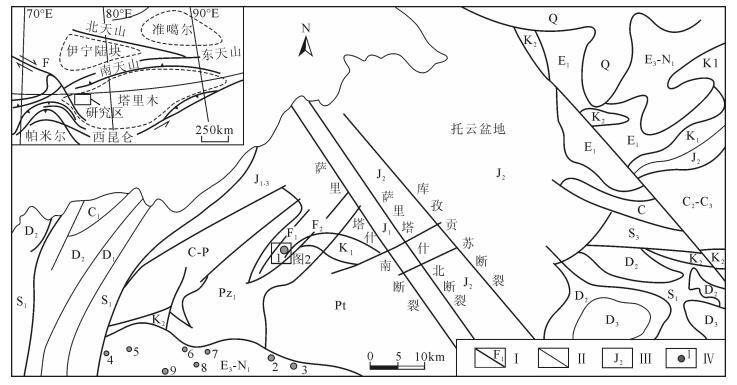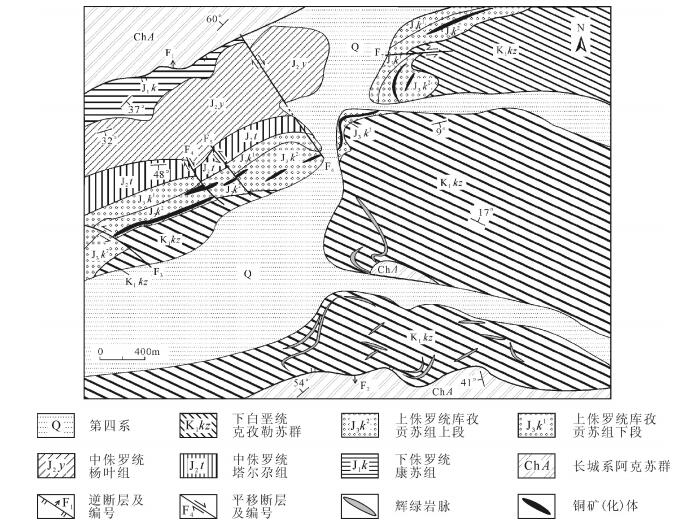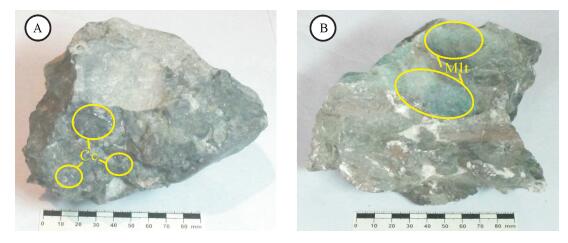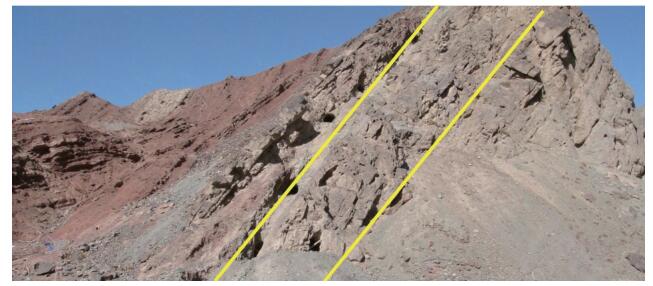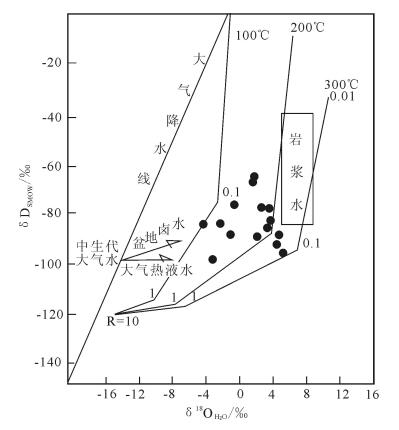Constraints on tectonic, fluid and metallogenic system evolution for the formation of Sareke sandstone copper deposit in northwestern Tarim block
-
摘要:
塔里木陆块西北缘萨热克砂岩型铜矿床构造演化、流体演化与成矿之间具有密切关系,处于一个统一系统中。矿床成岩期方解石中包裹体水的δD值为-65.3‰~-99.2‰,改造成矿期石英包裹体水的δD值为-77.7‰~-96.3‰,成岩成矿期成矿流体δ18OH2O变化范围为-3.22‰~1.84‰,改造成矿期成矿流体δ18OH2O变化范围为-4.26‰~5.14‰,指示萨热克铜矿成岩期、改造期成矿流体主要为中生代大气降水及其经水岩作用而成的盆地卤水。矿石中辉铜矿δ34S值为-24.7‰~-15.4‰,指示硫主要源自硫酸盐细菌与有机质还原,部分源于有机硫。构造与成矿流体演化对砂岩铜矿成矿起关键制约作用。盆地发展早期强烈的抬升运动使盆地周缘基底与古生界剥蚀,为富铜矿源层的形成提供了丰富物源,至晚侏罗世盆地发展晚期,长期演化积聚的巨量含矿流体在库孜贡苏组砾岩胶结物及裂隙中富集,在萨热克巴依盆地内形成具有经济意义的砂岩型铜矿床。
Abstract:There exist close relationships between tectonics, fluid evolution and formation of copper ore in the Sareke sandstone deposit in northwestern Tarim block, which constitute an integrated system. The δD values of inclusion water in the calcite of diagenetic stage are in the range of -65.3‰~-99.2‰, and the δD values of inclusion water in the quartz of metallogenic epoch are in the range of -65.3‰~-99.2‰, the δ18OH2O values of the ore-forming fluid in the diagenetic stage are in the range of -3.22‰~1.84‰, and the δ18OH2O values of the ore-forming fluid in the metallogenic epoch are in the range of-4.26‰~5.14‰, suggesting that the ore-forming fluid in the diagenetic stage and transformation period of the Sareke copper deposit mainly originated from the atmospheric water in the Mesozoic period and basin brine evolved from the water-rock interaction of the rainfall. The δ34S values of the chalcocite in the ore are in the range of-15.4‰~-24.7‰, suggesting that most of the sulfur originated from the bacteria and reduced organic carbon in the strata, with the addition of minor organic sulfur. The evolution of the tectonics and ore-forming fluid controlled the formation of sandstone copper deposits. In the early period of the basin development, the strong uplift movement caused the erosion of the basement and Paleozoic strata in the periphery of Sareke basin, which offered abundant provenance to the formation of copper-rich source layer. Toward the late period, i.e., Late Jurassic epoch, large amounts of ore-forming fluid after long-term evolution was concentrated in the agglutinate and fissures of conglomerate in Kuzigongsu Formation, forming sandstone copper deposits with economic value in Sareke basin.
-
Keywords:
- Tarim block /
- Sareke /
- sandstone copper deposit /
- tectonic /
- fluid /
- metallogenic system
-
SHMS(sediment-hosted massive sulphide, 以沉积岩为容矿围岩的块状硫化物)类矿床是一种极其重要的矿床类型。该类矿床是锌和铅的主要来源,分别超过世界储量的50%和60%[1]。SHMS类矿床在世界上主要分布在澳大利亚Mt.Isa-McArthur盆地、澳大利亚Curnamona克拉通、加拿大Selwyn山岭、南非Namaqualand盆地、印度Rajasthan、BeltPurcell盆地、爱尔兰Irish Midlands、德国Rhenish盆地等[2]。SHMS类矿床具有明显的时控性,多形成于古—中元古代(19~14亿年)和早—中古生代(5.3~3亿年) [3]。SHMS类矿床还具有明显的层控性,矿体均赋存在一定的地层层位中[3-4]。近年来对于该类矿床的研究又有新的进展,如黄志伟[4]认为,该类矿床既可以出现在离散板块动力学背景下的陆内裂谷、拗拉槽或被动大陆边缘裂谷,又可以出现在汇聚板块动力学背景下远离弧后的拉张断陷盆地,同生断层为其主要的控矿构造;成矿流体具有高fo2特征[5]。
德国拉梅尔斯贝格矿床是中欧华力西期最重要的SHMS类矿床之一。它的发现出于偶然,相传是在一次狩猎活动中,被一匹名为拉梅利乌斯的马刨开地面发现的,而后以这匹马的名字将该矿命名为拉梅尔斯贝格[6]。矿床的开采记录最早可以追溯到公元968年,直到1988年6月矿山才最终闭坑。矿石储量估计有2700×104~3000×104t, 平均品位为:Zn 14%、Pb 6%、Cu 2%、Au 1g/t、Ag 140g/t和重晶石20%[7]。这座矿山创造的财富是哥斯拉尔(Goslar)市发展的基础,同时也是中世纪德意志帝国的重要经济来源。现今,包括很多具有重要历史意义的地下采矿设施,以及地表的矿石处理厂在内,整个拉梅尔斯贝格矿区成为了一个博物馆,并且被联合国教科文组织(UNESCO)列入了世界文化遗产。
本文将拉梅尔斯贝格矿床作为一个SHMS类矿床的典型实例,介绍其基本地质概况、矿化特征及研究进展,以了解SHMS类矿床的主要特征,为中国开展该类型矿床的找矿勘查提供参考。
1. 区域地质背景
拉梅尔斯贝格矿床位于欧洲华力西造山带的莱茵海西期地体(Rhenohercynian terrane)(图 1)。该地体地处欧洲华力西复合拼贴地体的最北端,其北部推覆到劳亚古陆基底之上,南部与萨克森图林根(Saxothuringian)地块缝合接触。Berthelsen[9]认为,莱茵海西期地块向西延伸穿过阿登高地(Ar-dennes)一直到英格兰西南部,向东延伸到捷克共和国东北部的西里西亚—摩拉维亚一带。
哈茨地块是莱茵海西期内几个华力西地体中的一个隆起地块,由古生代沉积岩、火山岩和侵入岩构成[10],面积约90×30km2。其北部和西部以断层为界,南部和东部被二叠纪沉积岩和局部的火山岩覆盖。哈茨地块传统上被分为三大地质单元[11],即上哈茨、中哈茨和下哈茨。其中,上哈茨地块的沉积序列是连续的,虽然厚度和岩相在侧向上有很大的变化,但是并没有角度不整合或沉积不整合。拉梅尔斯贝格矿床位于上哈茨地块的西北角(图 1)。
上哈茨地块中的地层包括下泥盆统埃姆斯阶(Emsian)、中泥盆统艾菲尔阶(Eifelian)、中泥盆统吉维特阶(Givetian)、上泥盆统和下石炭统。埃姆斯阶总体上称为科尔贝格砂岩,由一系列中厚层状云母粉砂岩、砂岩和石英岩构成;艾菲尔阶的威森巴赫页岩(Wissenbach Shale)可以分为2个单元,下部单元由一系列薄-中厚层状细粒砂岩、粉砂岩和页岩构成,上部单元主要为深灰色页岩[7];吉维特阶由瘤状灰岩的压缩层序构成,深海光壳节石也越来越普遍;上泥盆统由厚约20m的深灰色微晶灰岩组成,之后逐渐沉积了泥质岩,反映了当时平静的沉积环境;下石炭统底部发育一套含大量黄铁矿的黑色页岩(明矾板岩或明矾页岩),在其之上沉积有燧石序列。
哈茨地块的泥盆纪—石炭纪沉积岩在华力西造山运动期间发生了变形,泥盆纪建造呈现一北西向褶皱,在晚石炭世变形达到最高峰,同时伴有低级变质作用(葡萄石-绿纤石[12])。同时,以辉绿岩为代表的区域火山活动发生在中泥盆世和晚泥盆世,在沉积岩中出现了部分层状凝灰岩,也反映了当时的火山活动。在页岩当中还普遍发育轴面劈理,劈理的产状相对一致,走向北东40°~60°,倾向南东38°~48°。在上哈茨地块,断层近垂直,主要走向为北西西—南东东向,并且有一个明显的侧向右旋及垂直方向的移动[7]。
在中欧华力西期的古生代火山沉积岩系中,赋存许多具有重要经济价值的层控贱金属块状硫化物和重晶石矿床、兰迪尔(Lahn-Dill)型层状铁矿化,以及众多的脉状贱金属、重晶石和萤石矿床[7]。在哈茨地块,除拉梅尔斯贝格铜-锌-铅-钡矿床外,还有许多其他的矿床,主要是脉状矿床,包括贱金属、重晶石、萤石等[7]。
2. 矿床地质特征
拉梅尔斯贝格矿床赋存于威森巴赫页岩中[8]。矿化层位于西哈茨隆起和哥斯拉尔海槽之间的转折端(图 2)。含矿地层以亮灰色和暗灰色纹层为特征,产于威森巴赫页岩沉积序列中的深灰色页岩中。与威森巴赫地层层序中的其他地层相比,含矿层中的碳酸盐含量明显更高,Walcher[13]认为,这些碳酸盐可能是热液成因。含矿层中含有大量的赋存在浅白色白云质纹层中的黄铁矿,这些黄铁矿以自形的颗粒状和细粒草莓状集合体产出。含矿层中Zn和Pb含量较高,但很少发现闪锌矿和方铅矿[7]。位于上哈茨地块的拉梅尔斯贝格矿床因华力西造山运动,矿化层发生褶皱,形成等斜向斜,使矿体厚度增加了一倍(图 2、图 3)。
![]() 图 2 拉梅尔斯贝格隆起到哥斯拉尔海槽横切面(据参考文献[7]修改)dmt1+2—中下威森巴赫页岩;dms—Sandband页岩;dmc—Calceola页岩;du—卡勒贝格砂岩;NL—新矿体;HW—上盘矿点Figure 2. Cross section through the Rammelsberg extending into the Goslar Through
图 2 拉梅尔斯贝格隆起到哥斯拉尔海槽横切面(据参考文献[7]修改)dmt1+2—中下威森巴赫页岩;dms—Sandband页岩;dmc—Calceola页岩;du—卡勒贝格砂岩;NL—新矿体;HW—上盘矿点Figure 2. Cross section through the Rammelsberg extending into the Goslar Through2.1 矿体特征
拉梅尔斯贝格矿床中经济价值最大的是老矿体(Old Orebody)、新矿体(New Orebody)和富含重晶石的灰色矿体(Grey Orebody)(图 3)。其他经济价值较小的矿体包括老矿体西、上盘矿点和Kniest[7]。
老矿体(包括老矿体西,是构造错断的老矿体的延伸)在走向上长约600m, 向深部延伸约300m, 厚约12m;新矿体垂深约500m, 真厚度约8m, 但由于褶皱作用使其厚度增加到约40m。新矿体是矿床中最大的矿体,铅锌储量为1930×104t, 估计品位为Pb 6%、Zn 14%和Cu 1%。该层状矿体向南东倾斜,倾角50°~60°。灰色矿体被硫化物矿体所叠覆,横向上与页岩相互穿插[14];Kniest矿体呈筒状矿化,受层控作用控制,呈菱形,长约1000m, 宽300m, 厚35m。其矿化位于老矿体的层状底板中及新矿体主要硫化物堆积往东南延伸的部分,是底板沉积物中的硅化部分,品位为Pb 1.5%、Zn 3%和Cu 1.3%。Muchez等[15]研究表明,Kniest为矿液补给带,热液流体沿Kniest向上运移并最终导致矿床的形成。Hannak[16]认为,Kniest是在华力西造山运动期间构造变形形成的与逆冲断层有关的不规则网脉。
2.2 矿物特征
拉梅尔斯贝格矿床的主要矿石矿物为黄铁矿、闪锌矿、方铅矿、黄铜矿和重晶石,其次为磁黄铁矿、毒砂、白铁矿、磁铁矿、辉铅铋矿、黝铜矿、自然金等;脉石矿物为铁白云石、萤石、方解石、石英和绿泥石[12]。由于重结晶作用和强烈的变形,硫化物的原生结构没有很好地保存下来。
黄铁矿和闪锌矿呈草莓状产出。在块状和条带状矿石中还可见结核状的成岩期黄铁矿,以及粒级层理、滑塌构造、重荷模等沉积构造[14-16]。Sperling[14]还展示了黄铜矿沿着闪锌矿内的特殊层理方向的结晶,这种结构可以与“黄铜矿病毒”结构进行对比[17],可能标志着黄铜矿开始交代闪锌矿[18]。
2.3 矿石类型
新、老矿体中的矿石分为块状矿石(LE)和条带状矿石(BE) 2类。其中块状矿石由黄铁矿、黄铜矿、闪锌矿、方铅矿及重晶石组成,在块状矿石内部还会出现清晰的侧向不连续的纹层;条带状矿石是一种有韵律的毫米级铁质白云石纹层(图 4-a),含细粒黄铁矿、闪锌矿和方铅矿,夹含黄铁矿的页岩。灰色矿体主要由细粒纹层状重晶石及共生的闪锌矿和方铅矿薄互层组成。Kniest矿化层由黄铜矿、黄铁矿、方铅矿和闪锌矿组成,矿石呈横切细脉状、透镜状和浸染状(图 4-b),常伴生石英、铁白云质方解石和绿泥石。
![]() 图 4 页岩中的条带状矿石(a)和Kniest矿石(b) (据参考文献[19])Figure 4. Banded ore in the shale(a)and Kniest ore(b)
图 4 页岩中的条带状矿石(a)和Kniest矿石(b) (据参考文献[19])Figure 4. Banded ore in the shale(a)and Kniest ore(b)2.4 蚀变
在拉梅尔斯贝格矿床中,容矿围岩的热液蚀变只表现为硅质和碳酸盐的少量增加,以及绿泥石矿物成分的轻微变化[7]。虽然细粒的电气石也出现在下盘岩石中,但被认为是沉积形成的[20]。含矿层与赋矿页岩中的绿泥石铁含量约为26%,但是矿体中的绿泥石铁含量会增加到37%~46%。绿泥石中的Fe/Mg值变化可能是接近热液活动中心的一个敏感指标[21]。
2.5 成矿阶段
根据详细的地质填图(图 1-c),矿体中的不同矿化类型与3个旋回有关,呈层状分布的块状矿石和条带状矿石组成了其中的2个旋回,条带状矿石和重晶石组成了另一个旋回(图 5)。Sperling[14]描述了Cu在核部和LE1及LE2底部富集的垂向分带特征。一些透镜状的重晶石矿产在LE1和上覆的BE2层之间的接触带上。同时,在老矿体的西缘和新矿体的东缘,发育一条富含重晶石的矿带。上覆BE3层在横向上的发育很局限,标志着新矿体中金属硫化物沉淀的结束。富含重晶石的层状灰色矿体在BE3层上方约6m产出,是该地区最后一期热液事件的产物[7]。位于新、老矿体东南边缘下盘的Kniest带富集石英,同时有锌铜矿化,标志着这种分带模型一直延伸到下盘[7]。此外,少量细脉状和浸染状硫化物产在块状硫化物下方300m处的Calceola页岩中。
![]() 图 5 拉梅尔斯贝格矿床中不同矿石类型旋回(据参考文献[7]修改)Figure 5. Different ore types in the Rammelsberg deposit
图 5 拉梅尔斯贝格矿床中不同矿石类型旋回(据参考文献[7]修改)Figure 5. Different ore types in the Rammelsberg deposit2.6 成矿年龄
拉梅尔斯贝格矿床的矿化年龄可以通过对威森巴赫页岩中古生物的研究推算出来。Reinaldo[8]对威森巴赫页岩中大量的动植物化石(包括腕足类、头足类、双壳类、海百合、珊瑚等)进行研究后发现,拉梅尔斯贝格矿床的矿化应该发生在艾菲尔期—吉维特期,这与Large and Walcher[7]的研究结论一致。
3. 矿床地球化学
3.1 硫同位素
Anger等[22]和Nielsen[23]发表了拉梅尔斯贝格矿床不同矿化类型中黄铁矿、闪锌矿、方铅矿、黄铜矿和重晶石的硫同位素数据。
黄铁矿的δ34S值变化范围为-15‰~+20‰,具有典型的成岩黄铁矿的特征。黄铜矿、闪锌矿和方铅矿中的δ34S值则较均一(5‰~10‰),块状矿石中硫化物的δ34S值为+5‰~+20‰ [7]。Nielsen[23]提供的数据表明,从Kniest到新矿体中的硫化物矿化,黄铜矿、闪锌矿、方铅矿的δ34S值逐渐变大。大部分重晶石的δ34S值为+20‰~+30‰,但Kniest中的重晶石及灰色矿体中的部分重晶石的δ34S值则较低(图 6)。
![]() 图 6 拉梅尔斯贝格矿床硫同位素数据图(据参考文献[7]修改)Figure 6. Sulfur isotope data for the Rammelsberg deposit
图 6 拉梅尔斯贝格矿床硫同位素数据图(据参考文献[7]修改)Figure 6. Sulfur isotope data for the Rammelsberg depositNielsen[23]用2个硫源来解释这些硫化物中的硫同位素数据,一个是热液成因,具有均一的δ34S值;另一个是生物成因,在矿化发生的地方细菌对海水中硫酸盐的还原作用。黄铜矿、闪锌矿和方铅矿中的硫来源于热液[23],成岩黄铁矿中的硫和重晶石中的SO42-来源于细菌对海水中硫酸盐的还原作用[14]。此外,Kniest中的重晶石是通过硫化物的氧化和溶解形成的[14],可能是其δ34S值较低的原因。
3.2 铅同位素
Doe等[24]指出,SHMS类矿床中铅同位素的形成经历了复杂的过程,包括地壳岩石在造山过程中发生熔融、沉积岩的改造、热液循环造成的沉积物的淋滤作用,以及在流体作用下发生的铅元素向矿化场所运移,是这些不同来源的铅同位素混合和均一作用的结果。
Tischendorf等[25]和Lévèque等[26]对哈茨地块的铅同位素进行了研究。由图 7可以看出,相比于哈茨地块的脉状矿化,拉梅尔斯贝格矿床中的铅同位素特征明显不同,方铅矿具有独特的铅同位素组成。此外,拉梅尔斯贝格矿床的方铅矿的铅模式年龄为340 ± 9Ma, 而地层的形成年龄约为400Ma。Tischendorf等[25]认为,华力西造山运动期间矿化岩石的变质重结晶作用造成了年龄的不同。
![]() 图 7 哈茨地块矿化层中矿石铅同位素的206Pb/204Pb和208Pb/204Pb值(据参考文献[7]修改)Figure 7. 206Pb/204Pb versus 208Pb/204Pb diagram of ore leads from mineralization bed in the Harz massif
图 7 哈茨地块矿化层中矿石铅同位素的206Pb/204Pb和208Pb/204Pb值(据参考文献[7]修改)Figure 7. 206Pb/204Pb versus 208Pb/204Pb diagram of ore leads from mineralization bed in the Harz massif拉梅尔斯贝格矿床中的铅同位素具有均匀一致的特征[12],其中206Pb/204Pb变化范围为18.242~18.311,208Pb/204Pb变化范围为38.087~38.312[27],Doe等[24]提出,这种特征和略异常的模式年龄可以用铅构造模式来解释。由此可见,拉梅尔斯贝格矿床中的铅应该来源于均匀的地壳。
4. 综合性成矿模式
4.1 拉梅尔斯贝格矿床与SHMS类矿床的对比
将拉梅尔斯贝格矿床的地质特征与SHMS类矿床的典型特征进行对比(表 1),可见拉梅尔斯贝格拥有SHMS类矿床的大部分特征。
表 1 拉梅尔斯贝格矿床与沉积型块状硫化物矿床特征对比(据参考文献[7]修改)Table 1. Attributes of the sediments-hosted massive sulfide(SHMS)deposits compared with the observations at Rammelsberg对比内容 沉积块状硫化物矿床 拉梅尔斯贝格矿床 形成环境 受断层控制的盆地内的沉积岩容矿。岩相和厚度横向上的变化反映了垂直构造运动和不同的沉降速率 哥斯拉尔海槽是以断层为边界的盆地,它与西哈茨隆起之间的沉积相和厚度有明显的变化。拉梅尔斯贝格位于西哈茨隆起和哥斯拉尔海槽之间的转折端附近 与盆地演化关系 矿化发生在盆地发展的后裂谷“热沉降”阶段 中泥盆统页岩序列是在后裂谷热沉降阶段沉积形成的 与岩浆活动关系 与岩浆活动在时间和空间上都有密切联系 哥斯拉尔海槽内的艾菲尔阶页岩序列中的辉绿岩岩床,含矿地层中见凝灰岩层 容矿围岩特征 容矿沉积岩:原地沉积岩是细碎屑岩和碳酸盐岩,它们都沉积在低能量环境中;异地沉积岩是在高能量环境中迅速沉积的粗碎屑岩、泥石流和砾岩,可能与同生沉积断裂活动有关 威森巴赫页岩序列中的页岩和粉砂岩反映了当时的低能量环境。局部的泥石流和松软沉积物变形 时代分布 沉积型块状硫化物矿床主要集中在中元古代和古生代 形成于泥盆纪 产出特征 块状硫化物矿化受层控产出,走向长达6km,厚度变化大。层状构造很常见 2个具有层状结构的块状硫化物矿体,一个层控重晶石矿体 筒状矿化特征 产出在块状硫化物下面的筒状矿化(脉、细脉和交代作用),可能为热液通道或者喷口 筒状矿化的Kniest带可能是层控块状硫化物的热液供给通道 品位和吨位 具有经济价值的矿体达到上千万吨的矿石量(一些元古宙矿床甚至有上亿吨矿石量),Zn+Pb品位大于10%,Cu通常并不重要 典型的具有经济价值的沉积型块状硫化物矿床,矿石储量27~30Mt,品位高,14%Zn+6%Pb,1%的Cu含量使其在沉积型块状硫化物矿床中也很少见 金属分带特征 Cu+Fe核靠近喷口,Pb和Zn分散在周围,在周边和/或者上覆有重晶石化 在块状硫化物中发现了Cu-Pn-Zn垂直分带,重晶石到处都有,但只在上覆的“灰矿”中富集 原生硫化物特征 原生硫化物主要为细粒闪锌矿-黄铜矿,并伴有磁黄铁矿和/或者黄铁矿,少量毒砂和黝铜矿 主要硫化物为黄铁矿、闪锌矿、方铅矿和黄铜矿,还有少量磁黄铁矿、毒砂、磁铁矿和黝铜矿 蚀变 常见硅化和碳酸盐化(主要为铁碳酸盐)。偶见电气石化、钠长石化、绿泥石化和绢云母化 Kniest微富集二氧化硅、绿泥石和钠长石。铁白云石是块状矿石的主要成分之一,菱铁矿脉也产在Kniest中 铅同位素特征 每个矿床中的铅同位素组成均一 拉梅尔斯贝格矿床的铅同位素组成均一 硫同位素特征 硫一般有2个来源:一个是热液来源,具有均一的δ34S值;另一个是生物还原海水硫,其δ34S值变化范围大。重晶石中的硫反映的是海水硫酸盐中的硫 拉梅尔斯贝格矿床中的硫有2种来源,一种是热液来源;另一种是生物成因,是细菌还原海水中硫 与大多数显生宙SHMS类矿床相比,拉梅尔斯贝格矿床相对富铜,原因目前还不清楚。富铜的源岩(如基性火山岩)和高温的矿化热液可能是主要原因,这可能与中泥盆世局部地壳破裂导致上哈茨地区产生的高地热梯度有关[28]。黄铜矿在温度低于300℃时具有可溶性[29],而高地热梯度可能会导致黄铜矿的溶解度降低,使拉梅尔斯贝格矿床的铜局部富集。
4.2 成矿物质来源
SHMS类矿床成矿流体的典型特征是成矿温度260℃,盐度8%~10%NaCl, 非常低的O2活性,非常高的CO2活性,低的H2S活性和弱酸-中性pH值[7]。尽管没有收集到拉梅尔斯贝格矿床的流体包裹体数据,但是矿物组合和硫同位素数据表明,成矿热液流体的化学特征可能与上述典型的SHMS类矿床相差不大。
SHMS类矿床热液流体的来源可以用盆地排烃模式来解释。在这个模式中,流体来源于下伏的沉积岩。对发育在封闭的孔隙中的含金属卤水来说,下泥盆统同裂谷期沉积的碎屑岩是合适的可渗透储集层。在中泥盆世,该含水层被上覆的后裂谷期沉积的页岩(威森巴赫页岩)封闭。深穿透的断层和在后裂谷伸展构造期间地热梯度的增加,使这些含金属的热液卤水被集中到喷口处沉积成矿[7]。
与盆地排烃模式不同,Russell[30]通过对一些典型SHMS类矿床的研究,认为SHMS类矿床形成于海底热液对流系统中。他把该系统分为3个阶段:早期低温阶段,流体和地壳矿物之间未达到平衡,只有Fe、Ca、Mn、Zn和部分Si被溶解;中期阶段,对流核下渗,温度升高,流体和黄铁矿达到平衡;晚期阶段,在最理想的条件下,对流核渗透到底部为止,流体温度继续升高,体积继续增大,这时Pb、Zn、H2S,甚至是Cu的溶解度都会提高。这种情况下形成的矿体会随着地层层序的上升,Cu含量逐渐增加。
Goodfellow等[31]提出了SHMS类矿床成矿流体的3种来源:① 来源于含有蒸发岩的泥质沉积物的埋藏作用和压实作用;② 来源于含有高盐度含水层的沉积序列;③ 来源于达到海侵点的裂谷沉降。
4.3 SHMS类矿床的成矿模型
大多数人认为,SHMS类矿床是同生沉积的[12,28,31],形成于喷流沉积的环境中(图 8)。此类矿床模型有以下特征[32]。
(1) 闪锌矿-方铅矿-黄铁矿-重晶石矿化呈层状分布,细层状硫化物在单一地层中横向延伸,同时含有沉积构造,例如粒级层理、交错层理、硫化物碎屑等。
(2) 硫化物层全部由热液矿物组成,夹层由少量同源的热液矿物组成,硫化物层和夹层之间接触界线截然。
(3) 硫化物层发生不协调褶皱,上覆未发生变形的地层。横向和纵向上的金属分带与交代作用无关。此外,一些矿床中的不整合接触的底板矿化和蚀变可能为流体卸载的通道。
5. 结论
(1) 拉梅尔斯贝格矿床的铜-锌-铅-钡矿体赋存于威森巴赫页岩中,具有明显的层控特点,是典型的以沉积岩为容矿围岩的块状硫化物(SHMS)矿床。矿床形成于泥盆纪,与同生断裂活动有关。
(2) 硫同位素组成显示,拉梅尔斯贝格铜-锌-铅-钡矿床有2个硫源,一个来自热液;另一个来自细菌还原的海水中的硫酸盐。与其他SHMS类矿床相比,拉梅尔斯贝格矿床明显富铜。
致谢: 成文过程中得到中国地质调查局西安地质调查中心陈隽璐、贾群子研究员、王志海高级工程师、叶美芳工程师的热心指导,野外工作中得到萨热克铜矿的大力支持,审稿专家提出宝贵的意见,在此一并致以衷心的感谢。 -
图 1 萨热克铜矿区域地质略图(据参考文献[7]修改)
Ⅰ—断裂:F—费尔干纳断裂;F1—萨热克巴依北逆断裂;F2—萨热克巴依南逆断裂;Ⅱ—地层界线;Ⅲ—地层及时代;Ⅳ—砂(砾)岩型铜矿床(点)及编号:1—萨热克铜矿;2—杨叶铜矿;3—花园铜矿;4—沙哈尔铜矿点;5—托克乔尔铜矿点;6—喀拉丹铜矿点;7—卡巴加特铜矿点;8—吉里德热铜矿点;9—丹格-恰比尔铜矿点;Q—第四系;E3-N1—渐新统;E1—古新统;K2—上白垩统;K1—下白垩统;J2—中侏罗统;J1—下侏罗统;C-P—石炭系-二叠系;D3—上泥盆统;D2—中泥盆统;D1—下泥盆统;S3—上志留统;S1—下志留统
Figure 1. Regional geological map of the Sareke copper deposit
图 2 萨热克铜矿床地质图(据参考文献[7]修改)
Figure 2. Geological map of the Sareke copper deposit
图 5 萨热克铜矿成矿流体水/岩同位素δ18O-δD交换图(底图据参考文献[20])
Figure 5. Plot of δ18O-δD for water/rock isotopic exchange of ore-forming fluids in the Sareke copper deposit
表 1 萨热克铜矿床氢-氧同位素组成
Table 1 H-O isotopic data of the Sareke copper deposit
样号 样品对象 成矿期 δDV-SMOW/‰ δ18OV-SMOW/‰ 均一温度/K δ18OH2O/‰ SRK-W1 方解石 成岩成矿期 -64.4 21.3 352.7 1.84 SRK-W3 -66.8 21.0 352.6 1.52 SRK-W4 -98.8 17.0 346.9 -3.22 SRK-W6 -76.4 19.9 343.6 -0.76 SRK-T1 石英 改造成矿期 -88.9 17.6 441.7 2.03 SRK-T2 -84.3 18.3 391.5 -2.27 SRK-T3 -78.4 18.9 448.6 3.89 SRK-T4 -89.4 18.4 467.0 4.76 SRK-T5 -77.7 19.4 428.6 2.69 SRK-T6 -82.8 17.7 462.1 3.71 SRK-T7 -84.5 18.2 376.5 -4.26 SRK-T9 -86.6 19.1 439.8 3.37 SRK-T10 -96.3 19.7 454.4 5.14 SRK-T11 -92.1 18.5 458.6 4.25 SRK-T12 -88.3 17.6 408.8 -1.04 表 2 萨热克铜矿床辉铜矿单矿物硫同位素组成
Table 2 Sulfur isotopic compositions of chalcocite single mineral from the Sareke copper deposit
样号 矿物 样品特征 δ34SV-CDT/‰ SRK-TW1 辉铜矿 灰色稀疏浸染状含孔雀石、辉铜矿矿石 -22.2 SRK-TW2 辉铜矿 灰色细脉状辉铜矿矿石 -18.5 SRK-TW3 辉铜矿 灰色团块状辉铜矿矿石 -16.9 SRK-TW4 辉铜矿 灰色稀疏团块状含孔雀石、辉铜矿矿石 -22.1 SRK-TW5 辉铜矿 灰色细脉状含孔雀石、辉铜矿矿石 -18.9 SRK-TW7 辉铜矿 灰色块状辉铜矿矿石 -15.9 SRK-TW8 辉铜矿 灰色块状含孔雀石、辉铜矿矿石 -15.4 SRK-TW9 辉铜矿 灰色稀疏浸染状含孔雀石、辉铜矿矿石 -17.3 SRK-TW10 辉铜矿 灰色团斑状含孔雀石、辉铜矿矿石 -24.7 表 3 萨热克铜矿床流体包裹体气相成分激光拉曼探针分析结果
Table 3 Laser Raman data of gas components of the fluid inclusions in the Sareke copper deposit
样号 成矿期 x气相/% CO2 H2S CH4 N2 H2 总和 SRK-LT1 4.00 39.9 56.1 100.0 SRK-LT2 59.7 40.3 100.0 SRK-LT3 71.8 28.2 100.0 SRK-LT5 52.5 47.5 100.0 SRK-LT6 成岩成 27.3 72.7 100.0 SRK-LT7 矿期 76.0 24.0 100.0 SRK-LT8 13.3 86.7 100.0 SRK-LT9 14.4 85.6 100.0 SRK-LT11 23.5 76.5 100.0 SRK-LT14 93.3 6.7 100.0 SRK-LT4 9.6 82.6 7.8 100.0 SRK-LT10 49.2 50.8 100.0 SRK-LT11 75.9 6.5 17.6 100.0 SRK-LT12 83.7 10.0 6.2 100.0 SRK-LT13 改造成 45.6 6.4 48.0 100.0 SRK-LT15 矿期 83.3 16.7 100.0 SRK-LT16 7.9 92.1 100.0 SRK-LT18 69.2 30.8 100.0 SRK-LT19 84.5 15.5 100.0 SRK-LT20 81.3 18.7 100.0 表 4 萨热克铜矿床流体包裹体液相成分激光拉曼探针分析结果
Table 4 Laser Raman data of liquid components of the fluid inclusions in the Sareke copper deposit
样号 成矿期 x液相/% CO2 H2S CH4 H2O 总和 SRK-LT1 0.01 99.99 100.0 SRK-LT2 100.00 100.0 SRK-LT3 0.30 0.01 0.01 99.67 100.0 SRK-LT5 100.00 100.0 SRK-LT6 成岩成 100.00 100.0 SRK-LT7 矿期 100.00 100.0 SRK-LT8 100.00 100.0 SRK-LT9 100.00 100.0 SRK-LT11 100.00 100.0 SRK-LT14 100.00 100.0 SRK-LT4 0.01 99.99 100.00 SRK-LT10 0.09 99.91 100.00 SRK-LT11 0.43 99.57 100.00 SRK-LT12 100.00 100.00 SRK-LT13 改造成 100.00 100.00 SRK-LT15 矿期 100.00 100.00 SRK-LT16 100.00 100.00 SRK-LT18 0.10 99.9.00 100.00 SRK-LT19 100.00 100.00 SRK-LT20 0.08 99.92 100.00 表 5 不同期次流体特征参数
Table 5 The characteristic parameters for different stages of fluid inclusions
测试参数 成岩成矿期(35个测试点) 改造成矿期(38个测试点) 冰点温度/℃ 范围 -7.7 ~ -1.2 -6.5 ~ -0.1 均值 -4.4 -3.6 均一温度/℃ 范围 72.2~173.5 120.3~260.7 均值 119.8 192.4 盐度/wt%,NaCl 范围 2.07~11.34 0.18~9.86 均值 7.04 5.73 流体密度/g·cm-3 范围 0.92~1.03 0.81~1.00 均值 0.99 0.91 流体压力/MPa 范围 246.16~500.46 222.34~461.14 均值 386.59 358.81 -
谭凯旋.砂岩铜矿地球化学和成矿动力学[M].北京:地震出版社, 1998. 祝新友, 王京彬, 王玉杰, 等.新疆萨热克铜矿——与盆地卤水作用有关的大型矿床[J].矿产勘查, 2011, 2(1):28-35. http://d.wanfangdata.com.cn/Periodical/ytgcj201101007 刘增仁, 漆树基, 田培仁, 等.塔里木盆地西北缘中新生代砂砾岩型铅锌铜矿赋矿层位的时代厘定及意义[J].矿产勘查, 2014, 5(2):149-158. http://kns.cnki.net/KCMS/detail/detail.aspx?filename=ysjs201402006&dbname=CJFD&dbcode=CJFQ 张振亮, 冯选洁, 董福辰, 等.西南天山砂砾岩容矿矿床类型及找矿方向[J].西北地质, 2014, 47(3):70-82. http://kns.cnki.net/KCMS/detail/detail.aspx?filename=xbdi201403010&dbname=CJFD&dbcode=CJFQ 白洪海, 石玉君.西南天山砂岩型铜矿地质特征及成因分析[J].新疆有色金属, 2008, 4:14-18. http://www.cqvip.com/qk/98333X/200804/27822270.html 胡庆雯, 刘宏林.新疆乌恰县萨热克砂岩铜矿床地质特征与找矿前景[J].矿产与地质, 2008, 22(2):131-134. http://kns.cnki.net/KCMS/detail/detail.aspx?filename=kcyd200802008&dbname=CJFD&dbcode=CJFQ 李志丹, 薛春纪, 辛江, 等.新疆乌恰县萨热克铜矿床地质特征及硫、铅同位素地球化学[J].现代地质, 2011, 25(4):720-729. http://www.cqvip.com/QK/96868X/201104/39175948.html 辛江.新疆乌恰县杨叶砂岩型铜矿地质特征及成因浅析[J].矿床地质, 2010, 29(S1):393-394. http://www.cnki.com.cn/Article/CJFDTotal-XBTK201510053.htm 高珊, 高纬, 赵良军, 等.新疆乌恰县花园铜矿遥感近矿找矿标志分析[J].测绘与空间地理信息, 2016, 39(8):42-44+48. http://kns.cnki.net/KCMS/detail/detail.aspx?filename=dbch201608012&dbname=CJFD&dbcode=CJFQ 高珍权, 方维萱, 王伟, 等.沟系土壤测量在新疆乌恰县萨热克铜矿勘查中的应用效果[J].矿产与地质, 2005, 6:669-673. doi: 10.3969/j.issn.1001-5663.2005.06.017 胡剑辉, 吉蕴生, 曾志钢, 等.新疆萨热克铜矿床地球化学异常评价研究[J].矿产勘查, 2014, 5(2):281-292. http://kns.cnki.net/KCMS/detail/detail.aspx?filename=ysjs201402021&dbname=CJFD&dbcode=CJFQ 刘宏林, 胡庆雯, 田培仁.关于新疆乌恰盆地中新生代砂岩型铅锌铜铀层次成矿问题浅析[J].矿产与地质, 2010, 24(2):113-119. http://www.cqvip.com/Main/Detail.aspx?id=34538927 陆俊吉, 胡煜昭, 江小均, 等.新疆乌恰萨热克铜矿北矿带库孜贡苏组沉积相、古流向、物源区及其找矿意义——来自砾石统计分析的证据[J].地质通报, 2016, 35(6):963-970. http://dzhtb.cgs.cn/ch/reader/view_abstract.aspx?file_no=20160613&flag=1 方维萱, 贾润幸, 王磊, 等.新疆萨热克大型砂砾岩型铜多金属矿床的成矿控制规律[J].矿物学报, 2015, 35(S1):202-204. http://kns.cnki.net/KCMS/detail/detail.aspx?filename=kwxb2015s1150&dbname=CJFD&dbcode=CJFQ 刘中华, 陆俊吉, 胡煜昭, 等.新疆萨热克铜矿控矿因素的探索[J].矿产与地质, 2017, 31(01):23-28. doi: 10.3969/j.issn.1001-5663.2017.01.003 罗金海, 周新源, 邱斌, 等.塔里木盆地西部中、新生代5次构造事件及其石油地质学意义[J].石油勘探与开发, 2005, 1:18-22. doi: 10.3321/j.issn:1000-0747.2005.01.005 冉祟英, 刘卫华.康滇地轴铜矿床地球化学和矿床层楼结构机理[M].北京:科学出版社, 1993. 张理刚.稳定同位素在地质科学中的应用[M].西安:陕西科学技术出版社, 1985. 郑永飞, 陈江峰.稳定同位素地球化学[M].北京:科学出版社, 2000. 谭凯旋, 龚文君, 李小明, 等.地洼盆地砂岩铜矿床的构造-流体-成矿体系及演化[J].大地构造与成矿学, 1999, 1:35-41. doi: 10.3969/j.issn.1001-1552.1999.01.005 王思程, 薛春纪, 李志丹.新疆伽师砂岩型铜矿床地质及S、Pb同位素地球化学[J].现代地质, 2011, 25(2):219-227. http://www.cqvip.com/QK/96868X/201102/37935139.html Bodnar R J. Reviced equation and table for determining the freezing point depression of H2O-NaCl solutions[J]. Geochim Cosmochim Acta, 1993, 57:683-684. doi: 10.1016/0016-7037(93)90378-A
刘斌, 朱思林, 沈昆.流体包裹体热力学参数计算软件及算例[M].北京:地质出版社, 2000. 新疆华维地矿工程技术有限公司. 新疆维吾尔自治区乌恰县萨热克铜矿勘探报告. 2013.




 下载:
下载:







